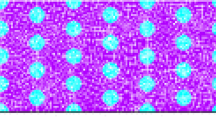Abstract
The copper/aluminum alloy and copper/steel/aluminum alloy composites fabricated by rotary forging at room temperature are studied. An analysis of the calculated forging reduction ratios of the components indicates a complex process of deformation of composite workpieces during forging from an initial diameter of 20 mm to a final diameter of 2.5 mm. Rotary forging leads to significant hardening of both the copper shell and the aluminum rod and to the appearance of a nonuniform microhardness distribution in the cross section of the samples, which levels off with increasing reduction. The mechanical properties of both composites are comparable after forging to a diameter of 5 mm: the yield strength and the ultimate tensile strength are 355–370 and 390–395 MPa, respectively, at a relative elongation of 2–3%. A consistent decrease in the sample diameter to 2.9 mm does not cause a noticeable change in the strength properties of the composites and decreases the ductility of the copper/steel/aluminum alloy composite material.







Similar content being viewed by others
REFERENCES
I.-K. Kim and S. I. Hong, “Influence of heat treatment on the bending behavior of tri-layered Cu/Al/Cu composite plates,” Mater. Design. 47, 590–598 (2013).
N. Ahmed, “Extrusion of copper clad aluminum wire,” J. Mech. Process. Technol. 2, 19–32 (1978).
Y. Mitani and H. Balmori, “Fabrication of a Cu–Al composite wire and its mechanical properties (Part I),” in Proceedings of 6th International Conference Strength of Metals and Alloys—ICSMA 6 (Melbourne, 1982), pp. 983–988.
Y. Beygelzimer, Y. Estrin, and R. Kulagin, “Synthesis of hybrid materials by severe plastic deformation: a new paradigm of SPD processing,” Adv. Eng. Mater. 17, 1853–1861 (2015).
O. Bouaziz, H. S. Kim, and Y. Estrin, “Architecturing of metal-based composites with concurrent nanostructuring: a new paradigm of materials design,” Adv. Eng. Mater. 15, 336–340 (2013).
R. Kulagin, Y. Beygelzimer, A. Bachmaier, R. Pippan, and Y. Estrin, “Benefits of pattern formation by severe plastic deformation,” Appl. Mater. Today 15, 236–241 (2019).
B. Huang, K. Ishihara, and P. Shingu, “Bulk nano-scale Fe/Cu multilayers produced by repeated pressing–rolling and their magnetoresistance,” J. Mater. Sci. Lett. 19, 1763–1765 (2000).
V. N. Danilenko, S. N. Sergeev, J. A. Baimova, G. F. Korznikova, K. S. Nazarov, R. Kh. Khisamov, A. M. Glezer, and R. R. Mulyukov, “An approach for fabrication of Al–Cu composite by high pressure torsion,” Mater. Lett. 236, 51–55 (2019).
R. Z. Valiev, R. K. Islamgaliev, and I. V. Alexandrov, “Bulk nanostructured materials from severe plastic deformation,” Progr. Mater. Sci. 45, 103–189 (2000).
R. Z. Valiev, Y. Estrin, Z. Horita, T. G. Langdon, M. J. Zehetbauer, and Y. T. Zhu, “Fundamentals of superior properties in bulk nanoSPD materials,” Mater. Res. Lett. 4, 1–21 (2016).
Y. Estrin and M. J. Zehetbauer, “Niche applications of bulk nanostructured materials processed by severe plastic deformation,” in Bulk Nanostructured Materials, Ed. by M. J. Zehetbauer and Y. T. Zhu (Wiley, Weinheim, 2009), pp. 635–648.
V. A. Andreev, V. S. Yusupov, M. M. Perkas, V. V. Prosvirnin, A. E. Shelest, S. D. Prokoshkin, I. Yu. Khme-levskaya, A. V. Korotitskii, S. A. Bondareva, and R. D. Karelin, “Mechanical and functional properties of commercial alloy TN-1 semiproducts fabricated by warm rotary forging and ECAP,” Russ. Metall. (Metally), No. 10, 890–894 (2017).
S. A. Nikulin, V. A. Kotrekhov, A. B. Rozhnov, V. M. Khatkevich, S. O. Rogachev, and A. S. Zavodchikov, “Mechanical properties and character of fracture of a tube billet made of an E110 zirconium alloy after radial forging at various strains,” Deform. Razrushenie Mater., No. 2, 36–42 (2012).
S. A. Nikulin, T. A. Nechaikina, A. B. Rozhnov, S. O. Rogachev, and V. Yu. Turilina, “Structure and mechanical properties of a three-layer material steel/vanadium alloy/steel after radial forging,” Metalloved. Term. Obrab. Met., No. 4, 28–34 (2018).
S. O. Rogachev, V. A. Andreev, V. S. Yusupov, V. M. Khatkevich, E. V. Nikolaev, M. M. Perkas, and S. A. Bondareva, “Structure and mechanical properties of bimetallic aluminum alloy/copper wires after rotary forging” Metalloved. Term. Obrab. Met., No. 12, 26–31 (2020).
R. Kocich, L. Kunčická, P. Král, and P. Strunz, “Characterization of innovative rotary swaged Cu–Al clad composite wire condoctors,” Mater. Design. 160, 828–835 (2018).
R. Kocich, A. Macháčková, L. Kunčická, and F. Fojtík, “Fabrication and characterization of cold-swaged multilayered Al–Cu clad composites,” Mater. Design. 71, 36–47 (2015).
Y. L. Wang, R. Lapovok, J. T. Wang, Y. S. Qi, and Yu. Estrin, “Thermal behavior of copper processed by ECAP with and without back pressure,” Mater. Sci. Eng. A 628, 21–29 (2015).
ACKNOWLEDGMENTS
We thank engineer A.A. Tokar’ for his assistance on the sample preparation.
Funding
This work was supported by the Russian Foundation for Basic Research and the Government of Moscow within the framework of scientific project no. 21-32-70015.
Author information
Authors and Affiliations
Corresponding author
Ethics declarations
The authors declare that they have no conflicts of interest.
Additional information
Translated by K. Shakhlevich
Rights and permissions
About this article
Cite this article
Rogachev, S.O., Sundeev, R.V., Andreev, V.A. et al. Mechanical Behavior of a Copper–Aluminum Clad Composite Material during Rotary Forging. Russ. Metall. 2022, 332–338 (2022). https://doi.org/10.1134/S0036029522040231
Received:
Revised:
Accepted:
Published:
Issue Date:
DOI: https://doi.org/10.1134/S0036029522040231



